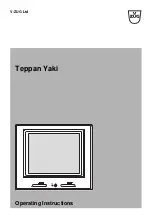
Page GB-9
The hob
Operating principle of an
inductive hob
Located beneath the glass ceramic surface
is a coil, through which current flows. This
coil generates an alternating magnetic field.
This induces eddy currents in a metallic pot
placed above it, which heat up the metal of
the pot and from there, heat the contents of
the pots through heat induction. The induc-
tion currents thus make the pot itself a heat
transmitter. Although the surface of the glass
ceramic hob heats up, this is not as a result
of the electric field, but as a result of the heat
that emanates from the pot.
Induction technology has two main advantages:
– Since heat is generated exclusively in the
pot, maximum heat utilization is ensured.
– There is no heat inertia effect: The cooking
process begins as soon as a pot is placed
on a cooking zone, and it ends when the
pot is removed from the cooking zone. In
this way, the cooking process is much fast-
er, which saves energy.
Noises generated when using
the hob
Induction-heating technology relies on the
property of certain metals, which vibrate
when high-frequency waves are applied to
them. Under certain circumstances, these vi-
brations can cause some slight noise. None
of these sounds arise from any technical
fault, nor do they indicate poor quality. They
are simply related to the induction technolo-
gy. They will have no negative impact on the
pots or the hob.
Possible noises:
– Deep humming sound similar to that of a
transformer
This sound may occur when a high heat
setting has been selected. The cause of
this is that a large amount of energy is trans-
ferred from the hob to the cooking device.
The hob
The sound will disappear or be reduced as
soon as the heat setting is reduced.
– Slight whistling
This sound may occur when an emp-
ty cooking device is placed on a cooking
zone. It disappears as soon as water or
food is placed in the cooking device.
– Crackling
This noise may occur when cooking devic-
es made of layers of different materials are
used. The noise is caused by vibrations at
the joints of the different material layers.
This noise occurs in the cooking device
itself. The sound may change depending
on the type and quantity of the food being
cooked.
– High whistling sounds
These noises may arise primarily with
cooking devices that are made of different
materials and specifically in the event that
these materials are used at maximum heat
setting on two adjacent cooking zones. The
noise will decrease as soon as the heat
setting is reduced.
– Whirring
When cooking on the induction hob, a slight
whirring noise may arise depending on the
pot, the fill level or the temperature. With
some pots, this noise may only arise while
they are heating up, and with others, only
once they are warm; in some, the noise will
arise only when the fill level is very low and
in others, only when they are completely
filled. The noise may be continuous or may
occur at intervals. It can occur in the same
pot on one cooking zone, but not on an-
other. Even when using the same pot on
the same cooking zone, the noise may
not occur every time. It may occur when a
specific pot is in a certain position on the
cooking zone – and may not occur again
the next time.
















































